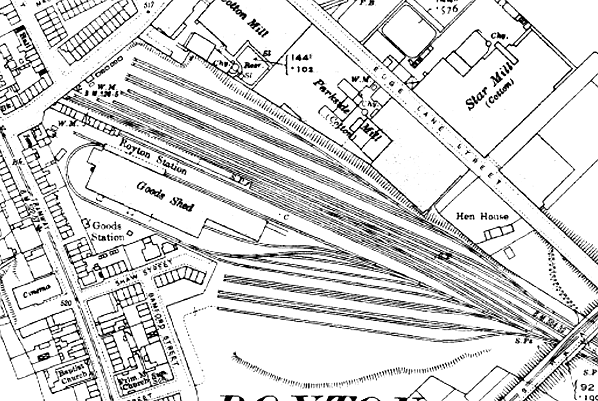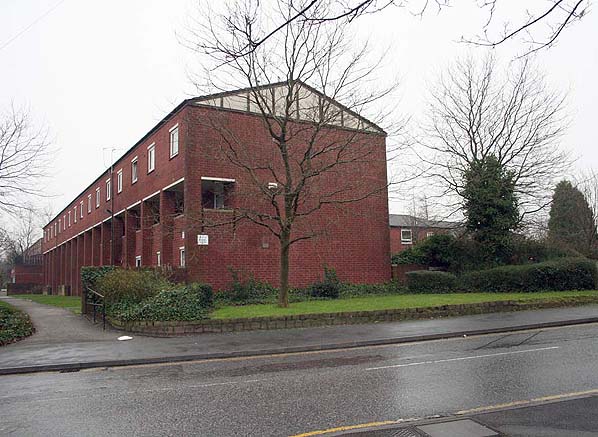|
Notes: Royton station was the terminus of a short branch that ran for just under one-and-a-quarter miles from the Lancashire & Yorkshire Railways (L&Y) Oldham Mumps to Rochdale line at Royton Junction. Royton was the only station on the branch. The line was opened primarily to serve the cotton-manufacturing town of Royton which had been missed by the Oldham Mumps to Rochdale line.
 |
Royton Station opened on 21st March 1864. Although the Royton Branch was double-track, the station was provided with only one platform on the south side of the line. This platform was very long, capable of taking an eight-coach train, as from the start it was planned that excursion trains, as well as ordinary passenger services, would use the station. At the west end of the platform |
was a single storey-brick building which contained a booking office in a booking hall, a ladies’ waiting room, a gentlemen’s toilet, an office for the stationmaster, a porters’ room and a lamp room. A canopy ran along the length of the building on its platform side. A water tower was provided at the east end of the platform. To the south of the station was a goods shed and, to its north, a number of sidings.
From the start the station was well served by passenger trains, mostly running from Manchester Victoria to Royton via Oldham. In 1922 eighteen services every weekday used the station. In 1923 Royton had become part of the London Midland Scottish Railway (LMS) which, in 1924, considered the branch for electrification as part of a project to electrify many heavily used passenger lines in the Manchester area. The electrification project was never taken forward.
| On 1st January 1948 Royton became part of the nationalised British Railways (London Midland Region). The station continued to be well served by passenger trains, but it fell into a state of disrepair. In 1956 British Railways undertook a survey and found that parts of the station were actually dangerous to its users; in particular, the canopy was singled out as a cause for |
 |
concern. British Railways considered modernisation of the station, as it was seen as an important source of revenue. However the only action taken was to remove the canopy. In 1958 there were still up to seventeen services per weekday, but Sunday services had ceased by this time. In the early 1960s British Railways introduced two-car Diesel Multiple Units to the line which proved very popular, and even more passengers started to use the line.
 |
On 8th February 1961 two ECS Cravens twin-units ran into the buffers at Royton Station at 40mph at 6:12am. Having demolished the buffer stops and the wall behind it, the train dropped about two feet to the level of High Barn Street and continued across it, entering two houses, and finally coming to rest with its front end projecting into their back yards. The leading |
bogie became detached and fell into the cellar of one of the houses. Damage was also caused to adjacent properties in the terrace row. Fortunately one of the properties was a lock-up shop, unoccupied at the time, and, due to the early hour, the occupants of the other houses were upstairs. It was concluded that the driver mishandled the brakes, as well as unwittingly accelerating the train, on the 1 in 62 descent to Royton Station. Five people were injured.
Despite the heavy passenger use the line was earmarked for closure in The Reshaping of British Railways (Beeching) report of 1963. Goods services finished on 2nd November 1964, and the last passenger service departed from Royton at 18:50 on Saturday 16th April 1966; official closure took place on 18th April. Shortly afterwards the line was lifted, and the station was demolished.
| Today the site has been developed as a residential area. The adjacent Railway Hotel is the sole remaining indication that a station existed at this location. However, about ¼ mile south from the station site the Shaw Road over-bridge still exists, retained for use by a footpath along part of the track-bed towards Royton Junction. |
 |
Source: An Illustrated History Of Oldham's Railways by J. Hooper - Irwell Press 2006
ISBN: 1871608198 and Railcar Association web site. Tickets from Michael Stewart
For more information and pictures of the Royton crash see Railcar Association web site
See also the Oldham Loop Line - click on the station name:
Dean Lane, Failsworth, Hollinwood, Oldham Werneth, Oldham Central, Oldham Mumps, Derker, Royton Junction, Shaw & Crompton, New Hey & Milnrow.
|

old13.jpg)



old1.jpg)
old4.jpg)
old5.jpg)



 Home Page
Home Page 




old_thumb12.jpg)
old_thumb2.jpg)
old_thumb3.jpg)
old_thumb6.jpg)
old_thumb7.jpg)
old_thumb8.jpg)
old_thumb9.jpg)
old_thumb10.jpg)
old_thumb11.jpg)



